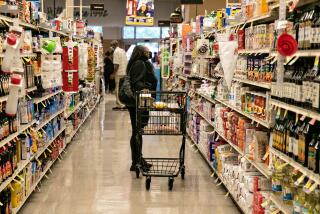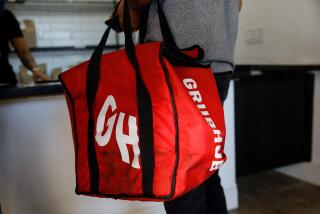Amazon and Whole Foods could revolutionize grocery delivery. But do shoppers want it?

Amazon said it is buying Whole Foods Market in a deal valued at about $13.7 billion, including debt. (June 16, 2017) (Sign up for our free video newsletter here http://bit.ly/2n6VKPR)
A giant in the technology industry had a bold idea: reinvent the way people shop, rendering grocery stores a quaint reminder of the past.
That company was Webvan, and it attracted $800 million in funding before filing for bankruptcy at the peak of the dot-com bust nearly two decades ago. The lesson in all this? Building a grocery business on wheels is terrifyingly expensive and inherently difficult because many shoppers simply aren’t ready to outsource their supermarket visits.
“Many people want to touch and feel their groceries,” said Peter Relan, the former head of technology at Webvan. “In focus groups, we found there was some deep evolutionary biology there. People said, ‘You’re not going to do what I’m going to do for my family.’ ”
It’s a challenge that continues to ring true today, even as interest in grocery delivery services has risen — culminating in news last week that the biggest of all e-commerce platforms, Amazon.com Inc., had bid $13.7 billion for one of the biggest names in the grocery industry, Whole Foods Market Inc.
The question now is whether the partnership between the two established firms will finally blow grocery delivery past its niche interest into the mainstream. Consumers ultimately got used to browsing for books online rather than on bookstore shelves; and they got over the fact they couldn’t try on clothes before shelling out cash online. E-commerce sales now total 8.5% of all retail sales in the U.S., according to the Department of Commerce, doubling its share since 2010.
If shoppers begin to embrace grocery delivery on a wider scale, that share will increase significantly given the size of the $800-billion grocery industry. But despite a host of services, including AmazonFresh, Instacart and Peapod as well as many supermarkets themselves, interest has been far from explosive. Having a stranger pick out and delivery your ribeye steak, it turns out, is not the same as having someone deliver your Christmas presents.
“The grocery industry is a completely different game when compared to items like books, media and electronics,” said Natan Reddy, a tech industry analyst at CB Insights. “Food delivery services on the whole are considerably more logistically complex.
“There’s also no simple way to gain a competitive advantage through variety, since a few specialty items aside, grocery is not a category where there’s too much variety in what consumers are looking for,” Reddy continued. “Since variety is out, it has to be price or convenience.”
Despite the difficulty, the business holds breathtaking potential. Unlike purchasing other consumer goods, shopping for groceries is a weekly endeavor for most households. Disrupting that task holds so much promise that money has been pouring into the sector the last five years — just as it did during the dot-com boom.
Grocery delivery companies have raised $713 million in funding globally through May, according to CB Insights, which puts it on pace to exceed last year’s record funding of $1.4 billion. In 2013, grocery delivery funding amounted to a paltry $83 million.
Among the chief barriers to success is warehousing and distribution. Perishable goods like fruit, dairy and meat need to be replenished regularly and delivered quickly. That requires intensive capital investment in cold storage, software, vehicles and labor. These costs, coupled with rapid expansion, is what ultimately doomed Webvan.
Amazon hopes to solve this problem with its acquisition of Whole Foods, which augments the Seattle company’s vast network of fulfillment centers with the grocers’ warehouses and 460 stores worldwide. That reduces the time that shoppers have to wait for food to appear on their doorsteps, and the distance that Amazon must travel to transport each order.
But that convenience comes at a price. Consider Amazon’s existing grocery delivery platform, Amazon Fresh. First, subscribers need to sign up for Amazon Prime, the premium subscription service that gives consumers free shipping and access to Amazon’s streaming entertainment for a fee of $99 a year or $10.99 a month. Amazon Fresh costs an additional $14.99 on top of Prime.
Other players in the space such as Instacart and Shipt don’t have to shoulder the infrastructure costs a more vertically integrated company like Amazon does. Instead, they act as a third-party delivery service selecting food from chains such as Publix and Costco. Subscribers to Birmingham, Ala.- based Shipt can choose between a $99 annual fee or a $14 monthly fee. Instacart, headquartered in San Francisco, charges $3.99 for two-hour deliveries and $5.99 for one-hour deliveries on orders of $35 or more.
Those fees run counter to what many consumers want: a discount.
Analysts at HSBC studying the British market last year found that no-frills grocers Aldi and Lidl were growing faster than the top online supermarket brand Ocado. They concluded that a discount was more important than convenience.
“Online retailing may be glamorous and exciting for those involved in developing it but the fact that the online grocery market continues to grow at only half the rate of discounters (and a quarter of the rate in cash terms) suggests consumers value lower prices over home delivery,” the bank said.
And therein lies the problem, said Relan, who now runs a Silicon Valley incubator. Webvan tried to be everything to everyone, rather than accepting that it was a premium service for those who could afford it. Mainstream interest in the service may be subdued until it can prove it’s a better deal.
One hope among delivery service founders and investors is that norms have changed. So much commerce is conducted online — thanks in large part to smartphones and apps — that getting milk delivered may soon become second nature, especially among young people.
“Consumers are becoming accustomed to getting pretty much anything they want delivered right to their door today, just by clicking ‘Confirm and Pay,’ ” said Roger Beahm, the WestRock executive director of the Wake Forest School of Business Center for Retail Innovation. “Having perfected this buying behavior in categories such as books and apparel, it’s not hard to visualize consumers getting to a similar tipping point in retail grocery once the logistics are there.”
On top of that, the way people value time as changed since Webvan crashed and burned in the Y2K era, said Ian Sigalow, co-founder of venture capital firm Greycroft Partners, which helped Shipt raise $60 million in two rounds of funding.
“Parents are saying the less time they spend in the grocery store, the more time they can give to their children,” Sigalow said. “It’s not just millennials. Shipt customers are also suburban moms who don’t have time and value convenience. There’s been a change in society the last 20 years.”
Relan remains skeptical of the mass-market home delivery model (save for the arrival of self-driving delivery cars). He’s far more bullish on a service that meets consumers in the middle like a drive-through where you can pick up your pre-ordered bag of groceries. That way shoppers can inspect their orders and sellers can save the enormous cost and complication of doorstep deliveries. Until a sustainable model is discovered, he said, e-commerce will continue to exhibit a gaping hole.
“Groceries really are the final frontier,” Relan said.
Follow me @dhpierson on Twitter
ALSO
Historical accuracy, not a diversity push, brought ‘Battlefield’ playable female characters
Trump’s answer to the obesity epidemic: Here, have a cookie
More to Read
Inside the business of entertainment
The Wide Shot brings you news, analysis and insights on everything from streaming wars to production — and what it all means for the future.
You may occasionally receive promotional content from the Los Angeles Times.











